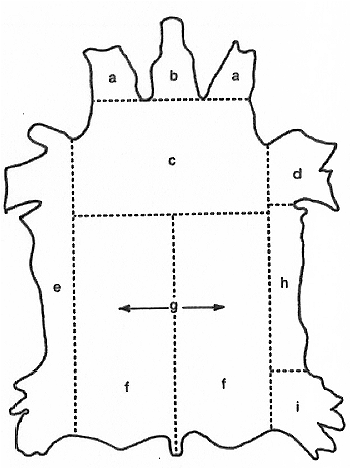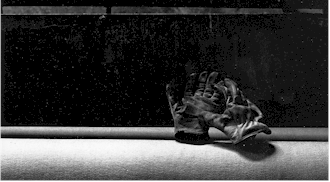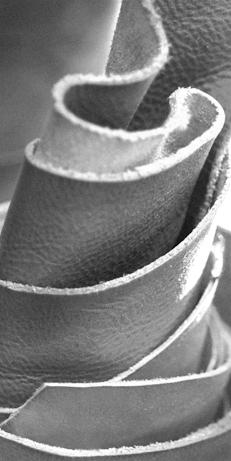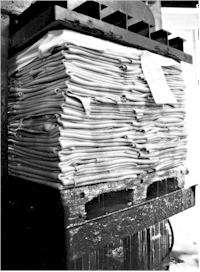|
buffed leather
leather from which the top surface of the grain has been removed by an
abrasive or bladed cylinder or, less generally, by hand. in the case of
upholstery leather the buffing process is invariable carried out by
machine though it is sometimes incorrectly described as hand buffed.
see corrected grain.
 |
Parts of a cattle
hide
a cheek
b face
c shoulder
d fore shank
e belly
f bend
g butt
h belly middle
i hind shank
|
butt that part
of the hide left after the bellies and shoulder have been removed.
butt split the
under layer split from the butt of a cattle hide.
calf the skin of
a young or immature bovine animal not exceeding a certain weight. in
italy, about 14 kilos, salted weight.
chrome re-tan
leather which has been first chrome tanned throughout its thickness and
subsequently further treated or tanned with vegetable and/or synthetic
tanning agents and/or resin filling materials, these retaining agents
penetrating notably, but not necessarily completely, into the interior.
chrome tanned
leather tanned either solely with chromium salts or with chromium salts
together with quite small amounts of some other tanning agent used merely
to assist the chrome-tanning process, and not in sufficient amount to
alter the essential chrome tanned character of the leather.
combination tanned
leather tanned by two or more tanning agents, e.g. chrome, followed by
vegetable (chrome retan), vegetable, followed by chrome (semi-chrome),
formaldehyde, followed by oil (combination oil).
cordovan leather
made from the shell of a horse butt, viz. from a kidney-shaped, very
compact layer occurring in the butt of equine animals only, and isolated
by removing the skin layer above and below it. it is vegetable tanned and
curried.
corrected grain
leather leather from which the grain layer has been partially
removed by buffing to a depth governed by the condition of the raw
material and upon which a new surface has been built by various finishes.
see buffed leather.
|
cow hide a.) the
outer covering of a mature bovine animal. b.) leather made from un-split
cow hide or its grain split. in some countries the term is also loosely
applied to similar leather from the hide of any bovine animal. the term
is not to be applied to leather from the flesh split.
|
 |
crock
particulate matter, usually colored, which can be removed from leather by
dry rubbing.
crushed patent
soft patent leather with a creased or crumpled appearance produced
mechanically after the patent finish has been applied and dried.
crust leather
leather which, after tanning, has not been further processed but has been
merely dried out.
culatta the rear
part of a bovine hide, comprising the butt, the belly middles and the hind
shanks.
curried leather
leather usually vegetable tanned which has been subject to the currying
process, i.e. a series of dressing and finishing processes applied to
leather after tanning in course of which appropriate amounts of oils and
greases are incorporated in the leather to give it increased tensile
strength, flexibility and water-resisting properties.
drawn grain an
unwanted shrunken grain appearance on leathers intended to have a smooth
grain or on the raw skin.
embossed leather
leather embossed or printed with a raised pattern either imitating or
resembling the grain pattern of some animal, or being quite unrelated to a
natural grain pattern.
finish a.) the
final process or processes in the manufacture of dressed leather. b.) the
surface coating applied to leather.
front the fore
part of a raw cattle or horse hide. when applied to a cattle hide it
consists of the shoulders and fore shanks.
grain the
pattern, characterized by the pores and peculiar to the animal concerned,
visible on the outer surface of a hide or skin after the hair or wool has
been removed.
grain leather
leather which has the grain layer substantially intact and is finished on
the grain side.
harness leather
a strong, flexible, curried, cattle hide, grain leather with a plain
finish, usually having a thickness of 4 to 6 mm.
hide leathers
made from the outer covering of a mature or fully-grown animal of the
larger kind which have not been split, or from the grain split; when used
in this way the name of the animal or the type of leather may be added,
e.g. cow hide or ox hide, bag hide or case hide.
impregnated leather
leather, which by means of the addition of materials such as grease, wax
and/or impregnating resins, etc., has been improved in certain of its
properties without thereby losing its typical leather characteristics.
insole leather
hide leather, including flexible splits, vegetable or combination tanned,
in sides, bends, shoulders and bellies, suitable for the inner soles of
footwear.
latigo leather
n. american term for cattle hide leather tanned with a combination of alum
and gambier, used for cinches, ties, saddle strings and other saddlery
work and for army accoutrements.
|
nappa soft, full
grain gloving or clothing leather made from un-split sheep, lamb, goat or
kid skins. it is usually tanned with alum and chromium salts and dyed
throughout its substance.
nubuck cattle
hide leather, buffed on the grain side to give a velvety surface; white or
colored.
patent leather
leather with a lustrous mirror-like surface, built up by the application
of one or more coats of daubs, varnishes or lacquers pigmented or
non-pigmented, based on linseed oil, nitrocellulose, polyurethane and/or
other synthetic resins.
pearlised leather
colored leather with a pearl-like luster.
protected leather
leather in which certain special chemicals have been incorporated to
render it less liable to deteriorate through exposure to polluted
atmospheres.
|

|
retanned leather
which has been subjected to an additional tannage with similar or other
tanning materials.
semi-aniline finished
leather which has been aniline dyed or stained, incorporating a small
quantity of pigment, not so much as to conceal the natural characteristics
of the hide.
shoulder leather
made from the fore part of a cattle hide covering the shoulders and the
neck of the animal, with or without the head. a squared shoulder is
obtained by cutting off the head.
shrunk(en) grain
leather specially tanned so as to shrink the grain layer and having a
grain surface of uneven folds and valleys.
side half of a
whole hide with offal (head, shoulder and belly) attached, obtained by
dividing it along the line of the backbone.
side leather
shoe upper leather made from cattle hide sides.
skin a general
term for the outer covering of an animal.
sole leather bend
leather made from the bend region of cattle hide, tanned and finished to
be suitable for the outer soles of footwear.
split if a hide
or skin is split over its whole area into several layers, this process is
termed splitting. the layers thus obtained are termed grain split
(outer split).
|
suede a generic
term for leathers whose wearing surface has been finished to have a
velvet-like nap.
suede calf calf
skin leather finished with a velvet-like nap on the flesh side.
synthetic tanned
tanned with synthetic organic agents.
tanning the
processing of perishable raw hides and skins by the use of tanning
materials into the permanent and imputrescible form of leather.
|
 |
vegetable tanned
leathers tanned exclusively with vegetable tanning agents or with such
materials together with small amounts of other agents used merely to
assist the tanning process or to improve or modify the leather, and not in
sufficient amounts to alter notably the essential vegetable character of
the leather.
waterproof leather
water-resistant leather which is thoroughly impervious to the
penetration of water.
water-resistant
(repellent) leather leather resistant (repellent) to the penetration
of water, usually chrome tanned or combination tanned, originally heavily
greased, but other water-resisting (repelling) agents may be used.
wet blue leather
leather which after chrome tanning has not been further processed and is
sold in the wet condition.
|
![]()